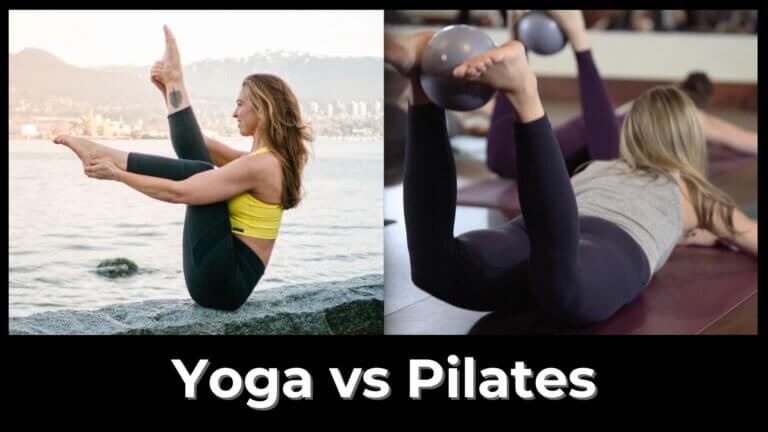I remember the first time my back really gave out on me. It was a random Tuesday, bending down to pick up my kid’s toy, and bam—sharp pain shot through my lower back like a lightning bolt. I froze, thinking, “Okay, this is it. I’m getting old.” But honestly, I was only in my mid-30s, juggling work, family, and zero time for self-care. Sound familiar? If you’re here, chances are you’ve felt that same ache, maybe from sitting at a desk all day or hauling groceries. Back pain sneaks up on so many of us, turning simple things like tying your shoes into a ordeal.
That’s where practices like yoga and Pilates come in. When we’re talking yoga vs Pilates for back pain, it’s not about picking a winner in some fitness showdown—it’s about finding what clicks for your body and helps you move without wincing. I’ve chatted with friends who’ve sworn by one or the other, and dug into the research myself. Both can build strength, improve flexibility, and offer that sweet relief, but they approach it differently. Let’s unpack this together, like we’re grabbing coffee and figuring out how to feel better.
By the end, you’ll have a clearer sense of which might suit you, or hey, maybe both. No pressure, just honest insights to help you reclaim your days without that constant nagging in your spine.
Understanding Back Pain: The Real Struggle Behind It
Back pain isn’t just a physical thing—it’s emotional too. It messes with your sleep, your mood, even your relationships. Why does it happen? Often, it’s a mix of poor posture from endless screen time, weak core muscles that don’t support your spine properly, or even stress that tightens everything up. According to the Mayo Clinic, about 80% of adults experience low back pain at some point, and it’s one of the top reasons people miss work.
Think about it: Our spines are like the backbone (pun intended) of our daily lives, but we rarely give them the TLC they need. Sedentary lifestyles make muscles lazy, and sudden movements can strain ligaments. Chronic issues might stem from disc problems or arthritis, but for many, it’s preventable with the right habits.
What if I told you low-impact exercises could change that? Both yoga and Pilates focus on mindful movement, which is key for back health. They encourage better alignment and breathing, reducing tension. But let’s dive deeper into each.
Yoga: A Gentle Path to Flexibility and Calm for Your Back
Yoga feels like a hug for your body and mind. It’s ancient, rooted in Indian philosophy, but today it’s all about flowing poses that stretch and strengthen. For back pain, yoga shines by improving flexibility in your spine and hamstrings, which often get tight and pull on your lower back.
Picture this: You’re in child’s pose, knees wide, forehead to the mat, arms stretched out. That simple stretch releases built-up tension in your back muscles. Studies show yoga can reduce chronic low back pain significantly. One review from the National Institutes of Health notes that regular yoga practice helps with mild to severe cases, easing pain and boosting mobility.
I once knew a guy, Mark, in his 40s, who dealt with desk-job backaches for years. He started with beginner yoga videos at home—nothing fancy, just 20 minutes a day. Within weeks, he noticed less stiffness in the mornings. “It wasn’t magic,” he said, “but it taught me to listen to my body.” Yoga’s emphasis on breath work also calms the nervous system, which can amplify pain when you’re stressed.
Common Yoga Poses That Target Back Pain
Cat-cow pose alternates arching and rounding your back on all fours—it’s like massaging your spine from the inside. Downward dog lengthens the hamstrings and calves, taking pressure off the lower back. And bridge pose strengthens the glutes and core, supporting better posture.
A 2020 study in PLOS One found yoga more effective than non-exercise for low back pain, with participants reporting less disability after consistent practice. But remember, it’s not one-size-fits-all. If a pose hurts, modify it or skip it.
Pilates: Building a Strong Core to Shield Your Back
Pilates, on the other hand, is like the precision engineer of workouts. Created by Joseph Pilates in the early 20th century for rehab, it zeros in on your core—the “powerhouse” that includes abs, back muscles, and pelvis. For back pain, this is gold because a weak core leaves your spine vulnerable.
Imagine lying on a mat, doing the hundred: Legs lifted, arms pulsing, engaging those deep abdominal muscles. It builds stability without jerking movements that could worsen pain. Research from the American Family Physician indicates Pilates reduces pain and disability in low back issues when taught by certified instructors.
Jen, a 42-year-old mom I met at a community class, had postpartum back pain that lingered. She tried Pilates on a whim and stuck with it. “It was tough at first,” she admitted, “but after a month, I could carry my toddler without that sharp twinge.” Pilates improves posture too, which Cleveland Clinic experts say is crucial for preventing pain as we age.
Pilates Moves That Strengthen Without Strain
The pelvic curl rolls your spine off the mat vertebra by vertebra, mobilizing the lower back safely. Single-leg circles challenge stability, firing up the core. And the teaser works the entire midsection for better support.
A recent study in Physiotherapy Theory and Practice highlighted Pilates’ benefits in managing chronic low back pain, often matching or outperforming other therapies. It’s low-impact, making it ideal if yoga’s twists feel too intense.
Head-to-Head: Yoga vs Pilates for Back Pain Relief
So, yoga vs Pilates—which wins for back pain? It’s not that simple. Yoga excels in overall flexibility and stress reduction, which indirectly soothes back issues by loosening tight spots. Pilates, though, targets core strength more directly, stabilizing the spine to prevent future flares.
Key differences: Yoga often involves more flowing sequences and spiritual elements, while Pilates is methodical, focusing on controlled reps. A comparison on Healthline notes both help with posture and balance, but Pilates might edge out for core-specific gains.
In terms of intensity, yoga can vary from gentle restorative to vigorous vinyasa, whereas Pilates stays consistent in its precision. For back pain, start slow with either. A 2019 randomized trial found both yoga and Pilates mat exercises equally effective in reducing pain and improving core stability in young women with nonspecific low back pain.
What about combining them? Many do, like yoga for stretch days and Pilates for strength. But listen to your body—if something aggravates your pain, back off.
What the Science Tells Us: Digging into Studies
Research is promising but mixed. A PMC study reviewed yoga and Pilates for low back pain management, concluding yoga might offer greater benefits in some cases due to its holistic approach. Another compared stabilization exercises (similar to Pilates) with yoga, finding each has unique advantages—yoga for flexibility, stabilization for performance.
WebMD’s overview of differences cites a review where Pilates reduced pain in various conditions, including back issues. Stats from Harvard Health suggest regular practice of either can cut pain by up to 30% in chronic sufferers. But always, quality matters—certified teachers make a difference.
Real Stories: How People Like You Found Relief
Hearing from others makes it real. Take Greg, who battled bad discs in his 30s. Doctors pushed surgery, but he experimented with yoga, Pilates, and more. What fixed it? Strength training, but Pilates laid the foundation for core stability.
Andreas shared his neck and back pain saga—years of agony until Pilates kicked in. After 30 sessions, pain vanished, leaving him feeling younger at 48.
Sarita, an educator and single parent, was bedridden from disc bulging. Yoga through Inner Engineering transformed her—doctors were stunned at her recovery.
Fleur found Pilates put her back pain in remission; quitting brought it back, restarting fixed it. These stories remind us: Persistence pays, and what works varies.
One Reddit user preferred Pilates over yoga for lower back, finding yoga too stretchy without enough support. Jasdeep used hot yoga for bad back pain, pairing it with tools for relief.
Getting Started: Safe Tips for Beginners with Back Issues
Ready to try? Start small. For yoga, grab a mat and follow free videos from trusted sources like Yoga Journal. Focus on back-friendly poses.
For Pilates, consider a class or app. Use props like blocks or a rolled towel for support. Always warm up, and stop if pain sharpens—discomfort is okay, pain isn’t.
Consult a doctor first, especially with severe issues. A physical therapist can tailor it. Aim for 2-3 sessions a week, building up.
Blending Yoga and Pilates: A Hybrid Approach
Why choose? Many blend them. Yoga for mornings to loosen up, Pilates afternoons for core work. A blog on Asana at Home suggests this combo for comprehensive relief—yoga releases tension, Pilates stabilizes.
When to Seek More Help: Knowing Your Limits
If pain persists despite trying these, see a pro. Conditions like herniated discs might need medical input. Experts at e-physiotherapy warn that too much flexibility without strength can worsen issues.
Therapy, meds, or even surgery have roles, but movement like this often complements them.
Taking That First Step Toward Relief
We’ve covered a lot— from how yoga stretches and soothes to Pilates’ core-building power. In the yoga vs Pilates for back pain debate, both can be game-changers, depending on your needs. Research shows they’re effective, stories prove they’re life-changing, and the key is consistency with kindness to yourself.
You’re not alone in this ache, and small changes can lead to big freedom. Why not try a gentle session this week? Head over to more Upvolta articles on posture improvement or low-impact workouts for extra tips. You’ve got this—your back will thank you.
FAQ
Is yoga or Pilates better for beginners with back pain?
It depends on your fitness level. Yoga might feel more accessible with its relaxing flows, but start with modified poses. Pilates offers precise control, great for building basics. Try both and see what feels right.
Can yoga make back pain worse?
Sometimes, if poses are done incorrectly or too aggressively. Always modify for your body, like using props, and avoid deep twists if they hurt. Consult a teacher experienced in back issues.
How often should I do Pilates for back pain relief?
Aim for 2-3 times a week, 20-30 minutes per session. Consistency matters more than intensity. Studies show benefits build over weeks, so be patient.
What’s the main difference between yoga and Pilates for posture?
Yoga improves overall alignment through stretches and balance, while Pilates focuses on core strength to maintain good posture daily. Both help, but Pilates might target slouching more directly.
Are there studies proving yoga helps chronic back pain?
Yes, multiple reviews, like one from PMC, show yoga reduces pain and improves function in chronic cases. It’s often as effective as physical therapy.
Does Pilates require equipment for back pain benefits?
Not necessarily—mat Pilates works wonders. Reformers add resistance but aren’t essential for beginners. Start simple.
Can I do yoga and Pilates on the same day?
Sure, if your body handles it. Maybe yoga in the morning for energy, Pilates later for strength. Listen for fatigue.
What if I have sciatica—yoga or Pilates?
Both can help by stretching and strengthening, but proceed gently. Poses like Halasana in yoga might relieve pressure, per some experiences. Get doctor approval first.
How long until I see back pain relief from these?
Many notice changes in 4-6 weeks with regular practice. A study found reductions in pain after 12 weeks, but it varies.
Is hot yoga good for back pain?
It can increase flexibility, but heat might strain if you’re new. Stick to room-temp yoga initially for safety.


